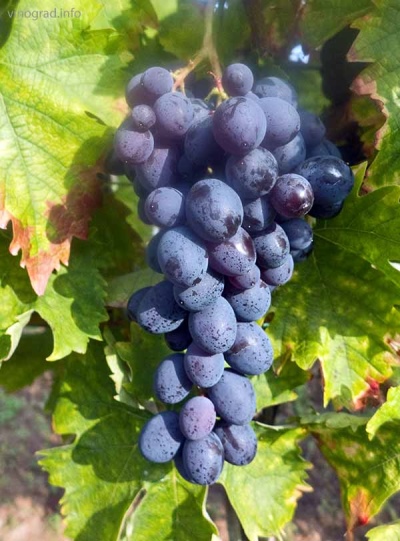
- Authors: England
- Appointment: universal
- Berry color: violet blue
- Taste: nutmeg
- With bones: Yes
- Ripening period: mid-late
- Ripening period, days: 148
- Frost resistance, ° C: -18
- Name synonyms: Black Hamburg, Fekete muskotai, Moscatel negro, Muscat de Hamburg, Black Alexandrian muscat, Salamanna rossa, Tamayosa nyagra Hamburg, Hamburg Misket, Tsibibo nero, etc.
- Bunch weight, g: 168-267
A grape is a vine-like plant with a long vine, on which bunches of berries appear during the growing season. The grape family is rich in varietal diversity. A grape called Muscat of Hamburg has gained great popularity.
Breeding history
This variety was bred in 1858 thanks to English breeders by crossing Frankenthal and Alexandrian Muscat. In 2003, a DNA examination was carried out, which confirmed this information. In 1859 it was approved for widespread use. This grape variety can be found under other names. It can be called Black Hamburg or Moscatel negro, Fekete muskotay. The western name is Black Muscat, in America - Golden Hamburg, the French gave the name Muscat de Hamburg, in the countries that were previously part of the Soviet Union, they call Alexandrian Black Muscat.
Geography of distribution
Today this grape variety is widespread almost everywhere. It can be found in Greece, Italy, Moldova, and other countries.
Description
The shrub is usually medium-sized, but on more fertile soils, the vine reaches a height above average. Leaves grow abundantly on the vine, which is a distinctive feature of the variety.
The young vine is pink, the older one is brown, with noticeable red nodules.
The leaf is large, wavy at the edges. It has a five-bladed shape. In spring and summer, it is painted bright green, in autumn it becomes yellow. The flowers are bisexual, but their pollability is low, so the variety is characterized by peas.
Ripening period
Medium ripening variety, 140-150 days should pass before harvest. Until technological maturity from the beginning of blooming, the sum of active temperatures is 2870 ° C.
Bunches
The bunches are usually large, conical, branched, with a loose density. They reach weights from 168 to 267 grams.
Berries
The berries are often rounded, sometimes elongated, oval, violet-blue, with seeds. The number of seeds is 2-3 pieces. The size of the berries varies from 12 to 26 mm in length and from 11 to 17 mm in width. Weight - from 3.1 to 4.1 g.
Taste
The berries have a pronounced nutmeg flavor. The flesh of the berry is fleshy and juicy, covered with a dense skin. It contains sugar up to 160-220 g / dm3, acidity - 6-8 g / dm3.
Yield
The yield of the variety is high, but unstable. 67% of all shoots bear fruit, the average fruiting coefficient ranges from 0.94 on developed shoots to 1.10 on fruiting ones.


Growing features
Muscat Hamburg does not tolerate the winter cold well, a drop in temperature of more than -18 degrees does not withstand, therefore, its cultivation is impossible in the northern regions.
Landing
Prefers loams, can grow on sandy soils. Bushes must be located at a distance of one and a half meters from each other, leave 1.5-2 meters between rows. Propagated by seedlings and cuttings. The best time for this is late October, early November.

Pollination
This grape variety is bisexual and does not require additional pollination.
Pruning
Shoots must be cut short, leaving 4 to 6 eyes on the vine. On average, 18-20 eyes should remain on the bush.

Watering
Provided that there is enough rainfall, this grape variety does not need additional watering. If necessary, it is better to resort to drip irrigation.


Top dressing
To obtain a higher yield, it is required to fertilize the land, this should be done 4-5 times a season. It is imperative to add nitrogen and phosphorus, since these elements have a direct effect on fruiting.
Frost resistance and the need for shelter
For the winter, shelter of the bush is required, since the frost resistance is low.

Diseases and pests
Muscat Hamburg is resistant to fungal diseases, but it is not resistant to mildew, powdery mildew, gray berry rot, bacterial cancer, phylloxera and pests.

If the grapes are exposed to any disease or insect, this is always reflected in its appearance.
Storage
It is used not only in the production of wine, it is excellent for eating, as it has excellent taste, so it can be safely called universal. It tolerates transportation well - the bunches are stored for up to 3 days.
It should be noted that the variety is suitable for growing in warm regions, in case of a lack of water, drip irrigation should be used, there is a need to fertilize the land.











































































